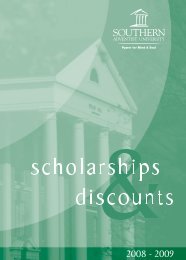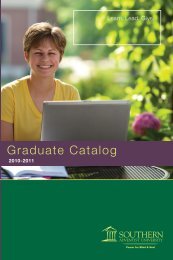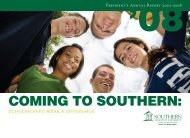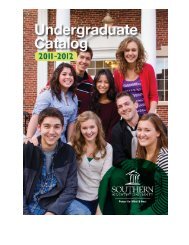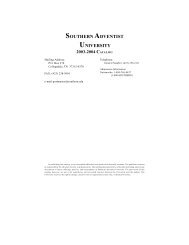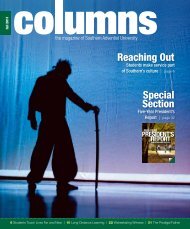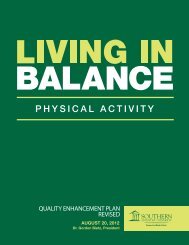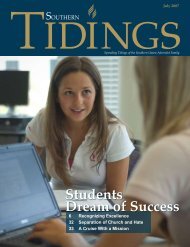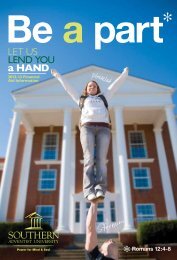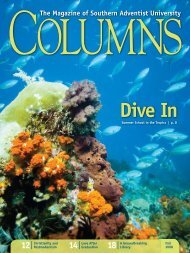Spring 2007 - Southern Adventist University
Spring 2007 - Southern Adventist University
Spring 2007 - Southern Adventist University
- No tags were found...
You also want an ePaper? Increase the reach of your titles
YUMPU automatically turns print PDFs into web optimized ePapers that Google loves.
Technology at <strong>Southern</strong><strong>Southern</strong> <strong>Adventist</strong> <strong>University</strong>’s Technology Department offers two-year degree programs in the areas of automotiveand drafting.What are your options?•Auto Service Technician (Two year degree)The auto technician program offers training in the following: engine repair, heat and A/C, electrical, drivetrainand axles, manual and automatic transmissions, computerized ignitions, fuel injection systems, andsuspension and alignment.•Architectural Drafter (Two year degree)The architectural drafting program provides students with skills in hand drafting and computer-aided draft -ing and design (CADD) as well as the industry-standard software, AutoCAD.•Technology Minor<strong>Southern</strong> also offers a program to earn a minor in technology. Courses involved in this 18-hour minor aresimilar to the technology majors but can be combined with any other major for academic diversity.Left to right: Rika Gemmell, John Munnoch, Oswald Fletcher, Kristina Benfield, Matt Gilbert, and Katie DexterSTAFF:Editors: Rika Gemmell & John MunnochLayout editor: Oswald FletcherPhoto editor: Matt GilbertWriters:Kristina BenfieldKatie DexterOswald FletcherRika GemmellMatt GilbertJohn MunnochAdvisor: Ron SmithFor more information about technology degrees:Ledford Hall4961 Industrial DriveCollegedale, TN 37315423.236.2863Online at:technology.southern.edutechnology@southern.eduphoto by Ron SmithTechnicallySpeakingThe Newsletter of Ledford HallD e s i g n i n g , c r a f t i n g , a n d b u i l d i n g f o r a b e t t e r t o m o r r o wMountains Moved at LedfordBy Matt GilbertFor some time, Ledford Hall hasbeen in dire need of additionalparking. With its community car repairservice, student projects, and donatedcars, Ledford was being overrun withvehicles, often making it impossible fordelivery trucks to get through and foranyone to find parking. The solutionwas 20 new parking spaces.“The new parking lot makes thingseasier, and we spend less time shufflingstuff around,” says Dale Walters, chairof Technology.The main obstacle was a large hillbehind Ledford Hall, and since therewas no other way to expand, the hill hadto be moved. Large earthmovers rolledin to remove tons of dirt, depositedconveniently in the Student Park, whichalso needed the dirt to build a levelgathering area for students.Now, 20 new parking spaces are available, andthere is plenty of room for extra vehicles and deliverytrucks. “The parking lot was definitely needed,” saysGreg Schleif, a junior business administration and autoservice major.In addition to the new parking lot, Ledford Hall isalso getting a new computer lab for its new program inarchitectural drafting.<strong>Spring</strong> <strong>2007</strong>Front-end loader clears dirt from behind Ledford for additional parking.“I’m very excited about the new drafting lab, and Ihope more good things will come for the architecturaldrafting program,” says Ryan Kloosterhuis, a freshmanarchitectural drafting major.The new lab will provide around 20 more draftingstations and a comfortable and professional setting forthe students. The remodeling is scheduled to take placethis summer.Content: Technology News—Page 2, Technology gets Creative—Page 6,Technology Goes Global—Page 4, Technology at <strong>Southern</strong>—Page 8Volume 4Issue 1photo by Matt Gilbert
Department Starts Technology ClubLedford Hall is now home to one of<strong>Southern</strong>’s newest clubs. The TechnologyClub, which was started this past fall,focuses on community service and providingnon technology majors a chance to learnabout the department.“By having this club,” says club presidentBrad Smith, “we hope to get more awarenessthroughout the campus and let people knowthat we do exist. Most important, though, isthat we can use our talents and skills to helpothers.”So far, club activities have included twoconvocations and a community serviceproject in which several students choseto spend their Sunday helping an elderlywoman with yard work. “It wasn’t much tous, but it meant a lot to her,” says Brad.The first convocation, held in the fallof 2006, highlighted speaker MarcusJaudas of Outpost Centers International,an organization that supports various<strong>Adventist</strong> ministries. Jaudas spoke on theimportance of mission activities. The secondconvocation, held last January, featuredDave Turner, a retired local contractor whodiscussed integrity in situations he hasfaced in both business environments and themilitary.Club advisor Ray Carson feels thatserving others is the primary purpose ofthe club, and he is excited about upcomingopportunities, including the club’sinvolvement in the Technology Department’sannual Car Care Day, when students providefree inspections of brakes, batteries, tirepressure, and general maintenance issues.Carson hopes to plan a longer mission2Technology Newsby Kristina Benfieldtrip and continues working with smaller local projectsinvolving repairs, construction, and other things thattechnology majors have the ability to help with because oftheir in-class experience.Sophomore Brad Smith is the first president of the newTechnology Club at <strong>Southern</strong> <strong>Adventist</strong> <strong>University</strong>.photo by Matt GilbertArt Meets Woodworkingby Rika GemmellThe pungent odor of burning wood wafts throughthe garage. The artist skillfully engraves the eyelashof a stallion into the wooden plank, carefullycopying her drawing. After months of planning andpreparation, the coffeetable begins to takeshape.Jennifer Seal, seniorgraphic design andmarketing major, is anartist of all mediums.Through her study in art,she has experimentedwith metalworking,glassblowing, blacksmithing, painting,charcoal, drawing,pottery, sewing, andwoodworking. Jennifertook woodworking classin the fall semester of2006 and started thework on her dreamcoffee table. Her projectcontinued when sheenrolled in a one creditdirected study class underTechnology Professor Ray Carson for the wintersemester of <strong>2007</strong>.The tabletop features three faces of horses, with“Being able to enjoy life in adeeper way and realize the beautyin the way things are made is whatmakes all the work worth it.”—Jennifer Sealeach design based on the grain direction of thewood. Pieces of wood, carved out of planks nowfit together like a puzzle, and the details give thehorses shape and definition. Every section of thecoffee table has been methodically planned andthought out, and although the process has takenmonths, Jennifer knows that it will be worth it. Inthe past, Jennifer has sold many of her pieces andhas plans for this particular coffee table to sit in herJennifer Seal displays her coffee table that she designed for woodworking class.living room. A glass top will overlay the woodenhorse design, protecting the wood from juice spills.Creating a coffee table as exquisite as Jennifer’sdoes not come easy. “Even before beginning theproject you have to have great attention to detail,think things out and plan ahead. With wood, youonly get one chance so you have to really thinkabout the project before running it through themachinery,” Jennifer says.Through the various mediums that the TechnologyDepartment has offered her, Jennifer hasrediscovered what it means to be an artist. “Overall,these skills add to the collection of perspectives. Ienjoy creating art; it keeps me from getting bored,”Jennifer says.photo by Matt Gilbert7
6TECHNOLOGY GETS CREATIVETechnology Student Builds Masterpiece—A Sea Kayakby John MunnochFirmly taking hold of the bow, Devon Horningslides the kayak into the water, creating ripplesas it breaks the surface. Seating himself in the firstposition, he takes hold of the paddle and digginginto the water, guides his hand-made sea kayak intothe emerald waters of Floridafor another adventure.A December 2006graduate of <strong>Southern</strong>, Devonis reaping the rewardsof what he achieved inhis Woodworking andConstruction classes atLedford Hall. Though Devonmajored in religious studies,he pursued a minor intechnology, which allowedhim firsthand experiencewith TechnologyDepartment ProfessorRay Carson. Carson hadpreviously constructed akayak, (see page 5), whichcaught the attention ofDevon and many otherstudents and faculty.In his last semester ofschool and needing upperdivision credit, Devon gotthe idea to build a wood strip and plywood kayak.“When I started working in the workshop, I sawMr. Carson’s wood strip kayak and got inspired,”he says.Devon immediately began work on a 21-foot longsea kayak, which he later named “Wild and Free.”He worked diligently, spending six hours a week onthe kayak during the semester and six hours a daythe last month before graduation.“I’d say all in all I probably spent a total of 200to 250 hours working on the kayak,” Devon says.contributed by Devon HorningDevon Horning nails pieces of woodstrip tohis kayak frame.After ordering all his materials, he began with aframe made out of marine plywood. He held thistogether with copper wiring, after which fiberglassglue was applied to seal the frame and the wiringwas removed. Devon then coated the inside andoutside of the kayak in morefiberglass glue to strengthen andwaterproof the kayak.Devon added a wood strip topto the kayak and finished it offwith a coating of fiberglass. Hethen coated the hull of the kayakwith epoxy mix and graphitepowder for abrasion resistanceand color. After adding apersonal design to the bow ofthe kayak, Devon was ready tohit the water in his hand-craftedmasterpiece.Creations like Devon’s kayaktake a significant amout of work,and therefore, satisfaction isone of the final products. “Theexperience is something I’llnever forget,” says Devon. “Thethings I learned in Woodworkingand Construction class havegiven me the ability to createthings on my own. Now my wifeand I can take the kayak out and enjoy the naturalbeauty of paddlingthrough a river insomething that haslots of memoriesfor me.”photo by Matt GilbertLedford Hall: An Innovative and Practical Approachby Oswald FletcherImagine life without a working vehicle; it can becomevery miserable and cause confusion. The automotiveprogram at <strong>Southern</strong> <strong>Adventist</strong> <strong>University</strong> has the basicand advanced tools that will prepare students to work onany vehicle.During class, students spend 30 percent of the timein the classroom and 70 percent working on cars.Small class sizes of 6-10 students allows for plentyof attention from the professors. The different topicsare engine rebuilding, performing oil changes, enginesystems, sensors, tune-ups, rebuilding exhaust systemsand transmission work.Master Mechanic Jonathan Peckam and seniormanagement major Matt Franks replace a distributercap on a student’s car.Construction Management to be Offered in 2008by Katie DexterWithin <strong>Adventist</strong> circles, there has been amindset that trade careers, such as plumbing,auto mechanics, and construction, are looked downupon as undesirable careers. <strong>Southern</strong> <strong>Adventist</strong><strong>University</strong> has begun breaking the barriers thathave bound these careers. Already <strong>Southern</strong>has an exciting auto mechanics degree andhas just started an architectural draftingdegree.In the fall of 2008, the TechnologyDepartment will beginoffering a construction managementdegree. In August of 2004,a committee of community memberswas organized to advise the TechnologyDepartment. Active committee member,Dave Turner, former local contractor, suggestedthat <strong>Southern</strong> <strong>Adventist</strong> <strong>University</strong> should start aphoto by Matt GilbertKeeping up with the technological advances of today,the automotive program has acquired several thousanddollars of equipment. The new equipment includes adigital multi-meter, which measures electricity; a scantool used to check vehicle information; and machineryfor brake rotors.Every car presents a different challenge for thestudents, and they enjoy learning problem-solvingmethods. When students finish a project car, they canalso enjoy the satisfaction of selling it.There are eight achievable certifications by the secondyear in the program, including heating, A/C, electricalengine repair, brakes, suspension/alignment, manual,and automatic transmission. All technicians receive theirautomotive service excellence certification within twoyears. The program also includes business classes totrain students to start their own businesses. The wellroundedclasses of the program create a versatile andchallenging learning environment for future mechanics.Students of different majors are encouraged to enrollin an elective mechanics class, such as Auto ElectricalSystems or Automotive repair to enrich their educationalexperience and become more well-rounded because ofthe practical knowledge taught.degree on the management of construction.The committee agreed that though some peoplebelieve these jobs to be undesirable, in reality,they pay well, allow a person to take off Sabbaths,and are fabulous career opportunities. Along withthe logistics of building, students will be taughtmany entrepreneurial skills. They will learnhow to manage construction sites, supervise,become subcontractors, and readplans as well as the ins and outsof bidding. Students will also belearning how to keep books andtake care of finances.This degree will do more than thatthough. Ray Carson notes its importanceand states, “It provides an interesting careertrack for students who do not fit in the traditionalcareers.”3
TechnologyGoes GlobalChanging Gears in Nicaraguaby John MunnochThe little plane shuddered and rolled from side toside as it began its descent into the humid tropicalclimate of Francis Sirpi, Nicaragua. Rob Durham, ajunior management major <strong>Southern</strong> <strong>Adventist</strong> <strong>University</strong>,and Dale Walters, chair of the Technology Department,were headed for Tasba Raya <strong>Adventist</strong> Clinic.The student and professor duo decided to spend theirspring break offering their mechanical expertise toperform repairs on the mission’sless-than-outstanding vehicles. Agroup of nursing students and stafffrom <strong>Southern</strong> accompanied themto give medical care at the missionclinic.While the nurses busied themselveswith the tasks of medicalcare, Walters and Durham beganworking on the clinic’s dilapidatedvehicles. “I worked on three trucksand a four-wheeler,” says Rob. Itwas his first trip to Nicaragua, butit was Walters’ third consecutivespring break in a row to the mission.Because all the roads in the areaare dirt, most of the work involvedrepairing the undercarriages of the vehicles. Rob assistedWalters in redoing the four-wheel drive hubs andreplacing the steering linkages on one truck. They alsospent a considerable amount of time (Walters estimateseight hours) welding the frame mounts of the truck bedback on. Another truck received some much-needed newbrakes, tires, and some structural welding. Rob says thehighlight of his work during the trip was being able toaccomplish what they set out to do. “There was morewe could have done, but we ran out of parts and time,”he says. “It was a cool experience, and I would definitelyconsider going back.”The clinic in Tasba Raya was originally built in 19714by <strong>Southern</strong>’s student association. Not long after, Nicaraguawas plagued by revolution and civil war, forcing themissionaries to leave the country and many of the communitymembers to flee as refugees to Honduras.The mission was abandoned until June of 1997, whena group from <strong>Southern</strong> went back to rebuild the structuresand reopen the clinic.Nursing junior Kathilee Davidson got a firsthandglimpse while working at the mission. “Seeing how thepeople really lived was eye opening,” she says. “Notonly do we provide attention at the clinic but we alsotravel around to other villages administering medicalhelp and education.” On average, 200-300 people visitthe clinic monthly to receive medical attention, accordingto recent estimates from <strong>Adventist</strong> Development andRelief Agency.“The best part about this trip was seeing the groupget enthused about helping and getting involved in thework,” says Walters. “Getting the work done is crucial tokeeping the mission going, but there is always more todo.”contributed by Kethilee DavidsonKayak Sold to Support Mission Pilotby Rika GemmellWhen he began work on a handmade woodenkayak, Technology Professor Ray Carsonhad no idea how he would be changed. After spendingcountless hours sawing, drilling, sculpting, and gluingthe kayak, Carson began to feel guilty for all of the workhe was putting into a project intended for himself. Whileworking late one night, Carson felt compelled to part withhis project and donate the proceeds to someone in need.From that moment on, Carson pushed forward with a newpassion and purpose for his kayak.Carson had found a worthy cause in a mission pilot inVenezuela named Bob Norton. Carson met Norton sixyears ago when he was considering flying for the missionfield. Norton’s work sparked a passion in Carson, and hehas supported Norton ever since.Even though there is much political instability withinthe country, Norton was allowed to stay because of hisvast influence, especially with the native people. Nortonused his occupation as a pilot to fly injured or sick peoplefrom the jungles to the nearest hospital, saving manylives.Flying beganto take its tollon Norton’sequipment andsoon his exhaustsystem went out.Carson’s donationof the moneyearned from thekayak was exactlythe amount that itRay Carson took his kayak for one last ride in British Columbia, Canada, beforeselling it on eBay.“Mission work is anextension of Christianideals. It’s importantto share whateverskills I have that willpotentially benefitothers” —Ray Carsontook to replace Norton’s exhaust system in his airplane.Because of Carson’s generosity, Norton will be ableto continue to provide help tothe Venezuelans who otherwisewouldn’t have it.“Mission work is anextension of Christian ideals.It’s important to share whateverskills I have that will potentiallybenefit others,” says Carson.Carson has made it apriority to be aware of missionopportunites all around him. Heshares stories of his experienceswith his students in his classes,and encourages them toparticipate in mission work aswell.“Carson’s committmentto detail on his kayak is areflection of his committment tothe mission in Venezuela,” sayscontributed by Ray CarsonJohn Munnoch, a senior masscommunication major.5



